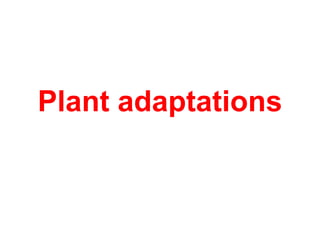
B1.4 plants adaptation
- 2. Adaptions of plants refers to ways in which the plant has undergone changes to its genes as well as physical appearance in order to survive in a hostile or competitive environment. Plants may be adapted to survive in dry environments by means of: o changes to surface area, particularly of the leaves o water-storage tissues o extensive root systems.
- 3. Saxifrage Arctic Willow Bearberry Arctic flower Cold climate plants
- 4. • Plants are small - usually less than 12 inches tall to avoid wind • Plants are dark - helps them absorb solar heat. • Small waxy leaves / needles • Some plants are covered with hair • Some plants grow in clumps for protection • Some plants have dish-like flowers that follow the sun
- 5. Many desert or arid plants have silver leaves or leaves covered with reflective hairs in order to reflect excessive heat.
- 7. Trees • many trees are evergreen • many trees have needle-like leaves to lose less water • waxy coating on needles • needles are dark in colour • trees have branches that droop downward
- 8. Plants in Dry Climates Adaptations: Can you think of any? Make a list.
- 9. • Some plants store water in their stems or leaves = succulents • Some plants have no leaves • Long root systems spread out wide or go deep into the ground to absorb water
- 10. • Spines to protect from being eaten • Plants slower growing so require less energy • Flowers that open at night lure pollinators who tend to be active during the night • Hair help shade the plant, reducing water loss
- 12. Cacti have evolved spines to replace leaves to reduce transpiration and offer protection from predators - most thorns and spines are protection adaptations.
- 13. Some desert/ arid region plants like Protasparagus have adapted underground storage organs to store water when it is periodically available
- 14. Other types of plant adaptation
- 15. Some vines have adapted tendrils or suckers to be able to hoist their foliage up into areas of optimal light and avoid the completion on the ground.
- 16. The Venus Flytrap has adapted "traps" to catch insects and supplement the nutrient requirements lacking in its natural soil. http://www.youtube.com/watch?v=O7eQKSf0LmY
- 17. Jungle plants have adapted large deep green leaf surfaces to maximise their exposure to the sun while on the jungle floor.
- 18. The entire nature and mechanism of deciduous plants is a survival mechanism, brought about so that the plants can preserve resources and endure long periods of frost or snow.
- 19. Scientists investigated two types of violet plants. One was found more frequently in shade, the shade violet. The other was found more frequently in sunny places, the sun violet. A B a) Which violet is which? b) Give a reason for your choice.
- 20. The number of violets in an area of woodland were counted before and after a large number of trees were removed. The results are shown below. i) State how light conditions would have changed when the trees were removed. (ii) Which of the plants survived better before the trees were removed? (iii) What happened to the number of these plants after the trees were removed? Violet type Before trees removed 2 years after trees removed 5 years after trees removed Shade 190 50 30 Sun 20 60 120